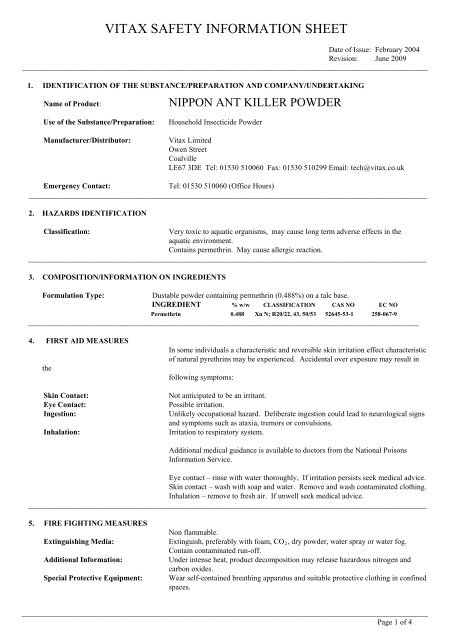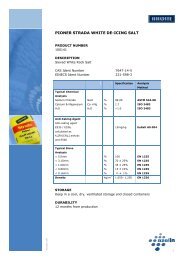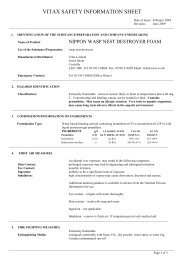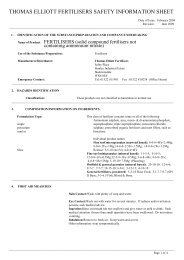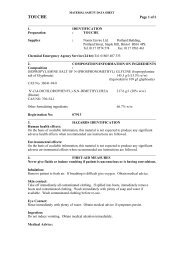VITAX SAFETY INFORMATION SHEET
Nippon Ant Killer Powder - Collier Turf Care Ltd
Nippon Ant Killer Powder - Collier Turf Care Ltd
- No tags were found...
You also want an ePaper? Increase the reach of your titles
YUMPU automatically turns print PDFs into web optimized ePapers that Google loves.
<strong>VITAX</strong> <strong>SAFETY</strong> <strong>INFORMATION</strong> <strong>SHEET</strong><br />
Date of Issue: February 2004<br />
Revision: June 2009<br />
__________________________________________________________________________________________________________<br />
1. IDENTIFICATION OF THE SUBSTANCE/PREPARATION AND COMPANY/UNDERTAKING<br />
Name of Product:<br />
NIPPON ANT KILLER POWDER<br />
Use of the Substance/Preparation:<br />
Manufacturer/Distributor:<br />
Household Insecticide Powder<br />
Vitax Limited<br />
Owen Street<br />
Coalville<br />
LE67 3DE Tel: 01530 510060 Fax: 01530 510299 Email: tech@vitax.co.uk<br />
Emergency Contact:<br />
Tel: 01530 510060 (Office Hours)<br />
________________________________________________________________________________________________________<br />
2. HAZARDS IDENTIFICATION<br />
Classification:<br />
Very toxic to aquatic organisms, may cause long term adverse effects in the<br />
aquatic environment.<br />
Contains permethrin. May cause allergic reaction.<br />
________________________________________________________________________________________________________<br />
3. COMPOSITION/<strong>INFORMATION</strong> ON INGREDIENTS<br />
Formulation Type:<br />
Dustable powder containing permethrin (0.488%) on a talc base.<br />
INGREDIENT % w/w CLASSIFICATION CAS NO EC NO<br />
Permethrin 0.488 Xn N; R20/22, 43, 50/53 52645-53-1 258-067-9<br />
______________________________________________________________________________________________________<br />
4. FIRST AID MEASURES<br />
the<br />
Skin Contact:<br />
Eye Contact:<br />
Ingestion:<br />
Inhalation:<br />
In some individuals a characteristic and reversible skin irritation effect characteristic<br />
of natural pyrethrins may be experienced. Accidental over exposure may result in<br />
following symptoms:<br />
Not anticipated to be an irritant.<br />
Possible irritation.<br />
Unlikely occupational hazard. Deliberate ingestion could lead to neurological signs<br />
and symptoms such as ataxia, tremors or convulsions.<br />
Irritation to respiratory system.<br />
Additional medical guidance is available to doctors from the National Poisons<br />
Information Service.<br />
Eye contact – rinse with water thoroughly, If irritation persists seek medical advice.<br />
Skin contact – wash with soap and water. Remove and wash contaminated clothing.<br />
Inhalation – remove to fresh air. If unwell seek medical advice.<br />
________________________________________________________________________________________________________<br />
5. FIRE FIGHTING MEASURES<br />
Extinguishing Media:<br />
Additional Information:<br />
Special Protective Equipment:<br />
Non flammable.<br />
Extinguish, preferably with foam, CO 2 , dry powder, water spray or water fog.<br />
Contain contaminated run-off.<br />
Under intense heat, product decomposition may release hazardous nitrogen and<br />
carbon oxides.<br />
Wear self-contained breathing apparatus and suitable protective clothing in confined<br />
spaces.<br />
__________________________________________________________________________________________________________<br />
Page 1 of 4
<strong>VITAX</strong> <strong>SAFETY</strong> <strong>INFORMATION</strong> <strong>SHEET</strong><br />
Date of Issue: February 2004<br />
Revision: June 2009<br />
__________________________________________________________________________________________________________<br />
6. ACCIDENTAL RELEASE MEASURES<br />
Personal Precautions:<br />
Do not breathe dust. Do not eat, drink or smoke. Wash hands and exposed skin<br />
after<br />
handling.<br />
Environmental precautions: Report to local water plc immediately if spillage enters drains and the Environment<br />
Agency or Scottish Environment Protection Agency if it enters surface or ground<br />
waters.<br />
Spillages:<br />
Sweep up any spillage carefully to minimise dust and transfer to heavy duty plastic<br />
bags or drums and keep safe before disposal.<br />
________________________________________________________________________________________________________<br />
7. HANDLING & STORAGE<br />
Handling:<br />
Do not block stack pallets.<br />
Storage:<br />
Store in original containers, tightly closed in a secure, well ventilated, cool but frostfree,<br />
dry area. Store clear of foodstuffs. Make arrangements for containment of<br />
accidental spillage.<br />
_________________________________________________________________________________________________________<br />
8. EXPOSURE CONTROLS/ Occupational exposure standards have been established (EH40) for talc, see<br />
PERSONAL PROTECTION regulatory information for details. No specific personal protective equipment<br />
assigned. Normal good hygiene standards should be observed.<br />
_______________________________________________________________________________________________________<br />
9. PHYSICAL & CHEMICAL Appearance off white powder<br />
PROPERTIES Odour none<br />
pH<br />
N/A<br />
Boiling point<br />
N/A<br />
Melting point<br />
N/A<br />
Flash point<br />
N/A<br />
Flammability<br />
non flammable<br />
Flammability limits (% vv) N/A<br />
Autoflammability<br />
N/A<br />
Explosivity<br />
N/A<br />
Oxidising properties<br />
N/A<br />
Vapour Pressure<br />
N/A<br />
Relative density<br />
0.45 (untapped)<br />
Solubility<br />
insoluble in water<br />
Other data<br />
none<br />
_____________________________________________________________________________________________________<br />
10. STABILITY & REACTIVITY<br />
Stability:<br />
Stable under normal conditions<br />
Conditions to Avoid:<br />
Avoid high temperatures.<br />
Materials to Avoid:<br />
Oxidizing agents, strong acids and bases.<br />
Hazardous Decomposition Products: Combustion or thermal decomposition will evolve carbon and nitrogen oxides and<br />
halogen compounds.<br />
________________________________________________________________________________________________________<br />
11. TOXICOLOGICAL Permethrin is of low mammalian toxicity and is readily metabolised and excreted<br />
<strong>INFORMATION</strong><br />
with immediate loss of toxicity.<br />
Acute toxicity for permethrin LD50 oral rat 7500 mg/kg<br />
LD50 dermal rat > 5100 mg/kg<br />
Technical permethrin is an eye and skin irritant.<br />
__________________________________________________________________________________________________________<br />
Page 2 of 4
<strong>VITAX</strong> <strong>SAFETY</strong> <strong>INFORMATION</strong> <strong>SHEET</strong><br />
Date of Issue: February 2004<br />
Revision: June 2009<br />
__________________________________________________________________________________________________________<br />
12. ECOLOGICAL <strong>INFORMATION</strong> Mobility: Studies to investigate the leaching potential of permethrin and its<br />
degradates showed that very little downward movement occurs in soil. Permethrin<br />
in the aquatic environment absorbs to vegetation and hydrosoil.<br />
Persistence and degradability: Permethrin degradation in soil has a half-life of 28<br />
days or less. The trans-isomer degrades more rapidly than the cis-isomer, with ester<br />
cleavage being the major degradative pathway.<br />
Permethrin disappears rapidly from the aqueous environment, in 6-24 hours from<br />
ponds and streams and 7 days from pond sediment.<br />
In water and on soil surfaces permethrin is photodegraded by sunlight. Ester<br />
cleavage and cis-trans interconversion are the major reactions. The degradative<br />
processes which occur in the environment lead to less toxic products.<br />
Bioaccumulative potential: Bioaccumulation of permethrin in mammals and aquatic<br />
organisms is not expected.<br />
Ecotoxicity: Permethrin is very toxic to aquatic organisms. Measured 96 hr LC 50 in<br />
fish ranges from 0.62-314 g/litre on a flow through test and 3.2-5.7g/litre in a static<br />
test. Permethrin has a very low toxicity to mammals and birds. However permethrin<br />
is very toxic to bees, with a 24 hr measured topical LD 50 of 0.029 g/bee.<br />
_______________________________________________________________________________________________________<br />
13. DISPOSAL CONSIDERATIONS Dispose of waste through a reputable waste disposal contractor or contact local<br />
Authority in accordance with Environmental Protection Act 1990.<br />
________________________________________________________________________________________________________<br />
14. TRANSPORT <strong>INFORMATION</strong> LQ27 Dangerous goods in limited quantities<br />
Environmental hazardous substance, Solid, N.O.S (Permethrin 0.488% mixture)<br />
UN 3077. Packing group III.<br />
________________________________________________________________________________________________________<br />
15. REGULATORY <strong>INFORMATION</strong> Approved under and labelled in accordance with the Control of Pesticides<br />
Regulations. Labelling under the Chemicals (Hazard Information and Packaging for<br />
Supply) Regulations:<br />
N: Dangerous for the environment.<br />
R50/53 Very toxic to aquatic organisms, may cause long term adverse effects in the<br />
aquatic environment.<br />
S7 Keep container tightly closed<br />
S22 Do not breathe dust<br />
S35 This material and its container must be disposed of in a safe way.<br />
S24 Avoid contact with skin<br />
S29 Do not empty into drains<br />
S49 Keep only in the original container<br />
Occupational exposure standards (EH40) in air. For talc: total inhalable 10 mg/m 3 (8<br />
hr) respirable 1 mg/m 3 (8 hr).<br />
The (COSHH) Control of Substances Hazardous to Health Regulations may apply to<br />
the use of this product at work.<br />
__________________________________________________________________________________________________________<br />
Page 3 of 4
<strong>VITAX</strong> <strong>SAFETY</strong> <strong>INFORMATION</strong> <strong>SHEET</strong><br />
Date of Issue: February 2004<br />
Revision: June 2009<br />
__________________________________________________________________________________________________________<br />
16. OTHER <strong>INFORMATION</strong> This product label provides information on a specific pesticidal use of the product:<br />
do not use otherwise, unless you have assessed any potential hazard involved, the<br />
safety measures required, and that the particular use is permitted under the Control<br />
of Pesticides Regulations.<br />
The information contained in this sheet is based on the best available information,<br />
including data from test results.<br />
The classification of this preparation was carried out in accordance with directive<br />
1999/45/EC and subsequent amendments modified by directive 2006/08/EC, taking<br />
account the directive 67/548/EC (Dangerous substances) modified by directive<br />
2004/73/EC and Regulation (EC) 1907/2006 (REACH).<br />
__________________________________________________________________________________________________________<br />
Page 4 of 4


